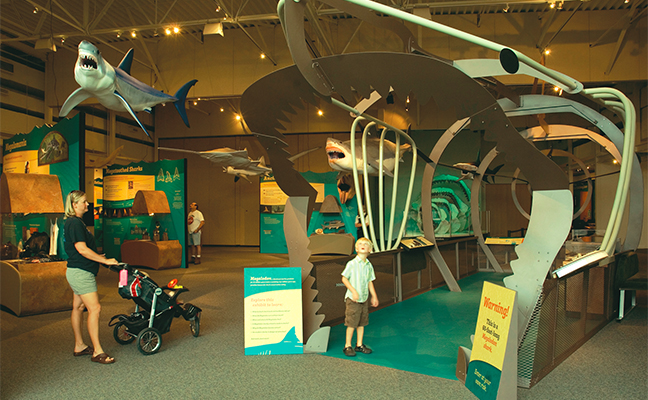
By CRISTINA JANNEY
Hays Post
The newest traveling exhibit to come to the Sternberg Museum of Natural History will feature the biggest shark to ever swim in the oceans.
“Megalodon: The largest shark that ever lived” will have a walk-in replica of the massive shark that stretched to 60 feet and weighed an estimated 72 tons.
The exhibit is set to open to the public on Saturday, Feb. 2. The museum will have a members-only opening from 7 to 9 p.m. Friday, Feb. 1. The traveling exhibit is set to be at the Sternberg through Labor Day.
Megalodon are believed to have lived 23 million to 2.6 million years ago. Despite myths and legends perpetuated by movies like last summer’s “Meg,” the megalodon is long extinct.
As with modern sharks, megalodon bodies were primarily comprised of cartilage. All that remains of these giants today is their teeth, which could grow to seven inches. Megalodon were on the scene after the inland sea that covered Kansas vanished. However, fossil teeth can still be found in the Carolinas.

Portions of the exhibit will allow people to look and touch megalodon teeth as well as view the progression of the shark’s jaw size as they grew from 30 feet to their full 60 feet.
Scientists believe megalodon preyed upon whales. Tooth marks have been found in fossilized whale bones.
Scientists are divided about the relationship between megalodon and modern sharks. Some scientists believe the megalodon are related to modern great white sharks and makos. However, others believe the megalodon evolved into another shark species that is also now extinct.
Visitors to the exhibit will also learn about modern sharks, their habitats and prey.
Darrah Steffen, Sternberg public relations assistant, said she thinks Americans’ fascination with sharks is born out of fear. However, she said it is important to dispel myths and create awareness to protect modern sharks in the wild.
“I think it is important to bring awareness even if we are in the middle of the United States,” she said. “Because you don’t want people to fear [sharks] if they ever come in contact with them.”

Rachel Unruh, marketing intern, noted sharks are not the mindless killing machines as they have been portrayed. Sharks are calculated hunters and humans are not their typical prey.
“It is fear to fascination,” she said of the exhibit.
The exhibit was created by the University of Florida.
